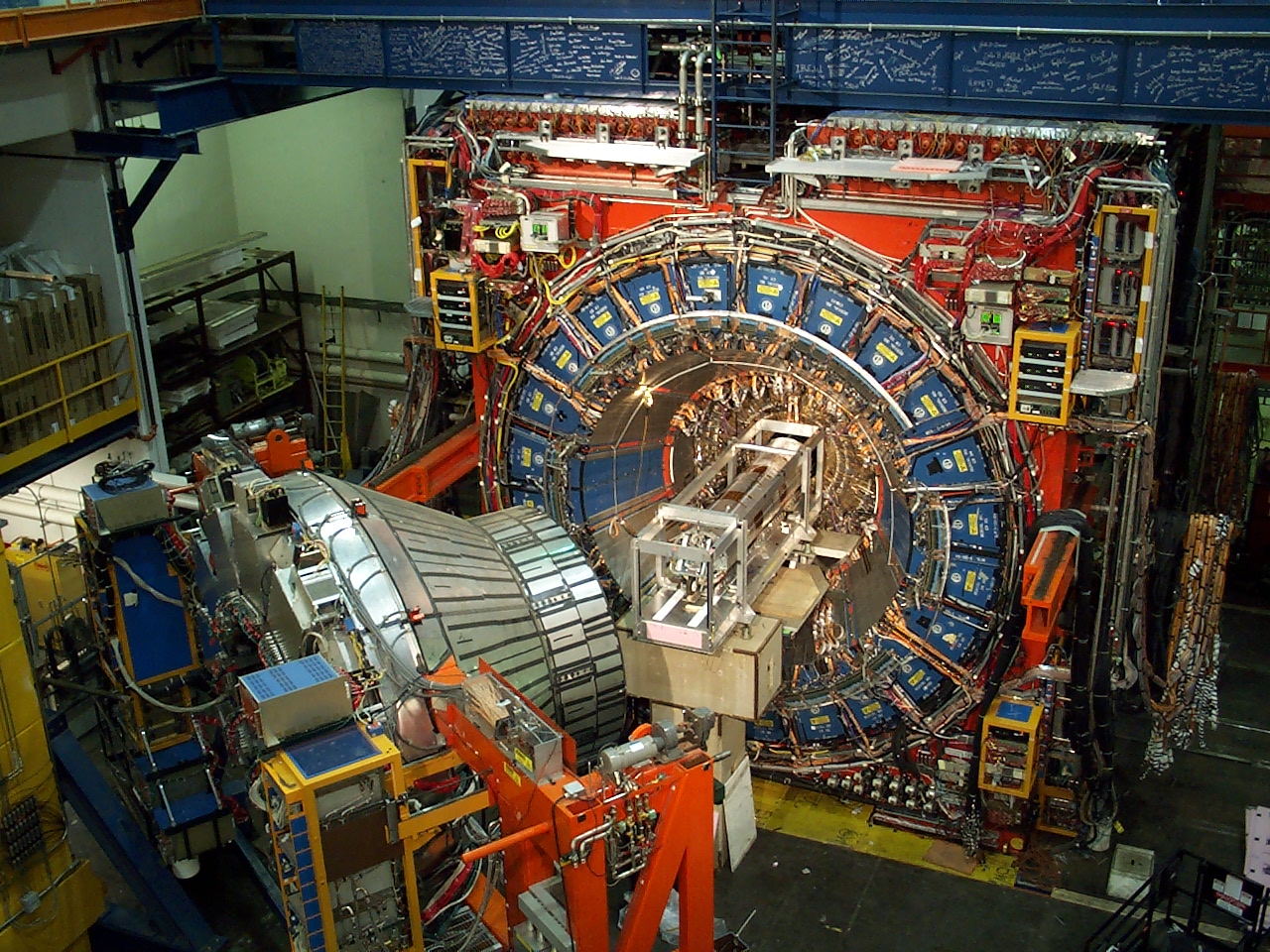
image credit: http://www-cdf.fnal.gov/
Introduction
The Bottom (or B) meson, discovered in 1976, exhibits
many highly interesting properties that make it an exciting topic of physics
study even today. Two of the properties this meson has are manifest in “mixing”
and in “CP violation”. Mixing occurs when the eigenstates of “particle” and
“antiparticle” do not correspond to the mass eigenstates which are often termed
“heavy” and “light”. In this case there is a disconnect between how the meson is
created and how the meson propagates through space. At creation the B meson must
be either a “B” or an “anti-B” meson. But in order to travel through space with
a given energy and momentum the meson must have a definite mass. When the B
meson is neutral there is no independent way to identify “B” and “anti-B” during
propagation. This causes the flavour of the particle to change from particle to
anti-particle and back again as it travels through space as one of the mass
eigenstates. This is the property of “mixing”.
CP violation was first observed in the kaon system, but in the B meson system it
is a much larger effect. CP violation is one of the requirements needed in order
to produce an asymmetric Universe with regard to matter and anti-matter. It is
likely that you owe your very existence to this property of the B meson!
In this lab you are going to search for the B meson via its decay to the J/ψ particle and a charged kaon. You will measure it's mass and explore the effects of making various cuts. There is a second lab associated with this one where the lifetime of the B meson is measured. However, to do that lab you first need to have done this one so that you will be familiar with the framework that is used to analyze the data.
Particle physics research relies heavily on using data analysis programs, often based in ROOT, to process vast amounts of data and pick out relevant results. In this lab you will look at event data from the Collider Detector at Fermilab (CDF) and write some ROOT code to calculate information about J/ψ and B mesons formed in collisions.

image credit: http://www-cdf.fnal.gov/
The Collider Detector Facility (CDF) is a multi-purpose detector at the Tevatron, Fermilab's proton-antiproton collider. It detects and records the tracks of high-energy charged particles produced in collisions. Mesons like the J/ψ can be produced but not directly detected in the Tevatron due to their extremely short lifetimes- they decay before they can travel far enough into the detector to be recorded (although in the case of the J/ψ, its neutral charge would also prevent it from being detected even if it lasted long enough). Instead the particles produced in the meson's decay are detected and their parent particle's existence is inferred from the groups of tracks. The J/ψ commonly decays into a muon/anti-muon pair, which can be detected. The muon does decay on a timescale of 2 microseconds, but this is considered a long enough lifetime to be a stable particle in terms of detections! The B meson can decay into a J/ψ and a kaon, so after finding J/ψs you will be able to use that data to find B mesons.
The detector is capable of picking up signals from protons, electrons, muons, kaons, pions, and their anti-particles. To find the J/ψ, we'll use only tracks that have been recorded in the muon chambers. These chambers lie behind a series of layered, cylindrical calorimeters made of lead and steel. Since a muon interacts less strongly with the nucleus than a pion or a kaon, and it carries more momentum than an electron due to its higher mass, those meters of steel and lead effectively filter out all particles but the muons and anti-muons which smash right through.
Other detectors exist inside of the calorimeters to record those tracks that won't make it to the muon chambers, most of these tracks will have been left by kaons or pions. These detectors produce the pictures of curved tracks that one can find on any of the current web-sites for running high energy physics experiments (CDF, D0, at Fermilab; ATLAS, and CMS at the Large Hadron Collider).
When a group of tracks that corresponds to the right
number and type of particles is found- two muon tracks for the J/ψ
decay, for example- conservation of energy and momentum can be used to deduce
the original particle's mass and momentum through the special relativistic
energy formula:
![]()
A histogram of the masses
found in this way from all of the events should have a clear peak at the
expected mass of the original meson. Cuts can be made on the data to
further separate the signal of real J/ψs
from random background noise by ensuring that the tracks used are well-measured
and converge realistically close to the beam spot.
The J/ψ meson is a neutral vector meson composed of a charm quark and a charm anti-quark with a mass of 3.097 GeV/c^2. Its lifetime is on the order of 10E-20 seconds - an unusually long lifetime for such a heavy meson that can also decay through the strong interactions. The length of its life can be explained by the OZI Rule of quantum chromodynamics, which says that any strong interaction which relies on gluons to carry all of the energy at any point in time has a lowered probability of occurrence. Since the J/ψ can decay only by an OZI-suppressed interaction, its decay rate is lower than would otherwise be expected. When the J/ψ was first detected in November of 1974, its existence and lifetime took physicists by surprise.